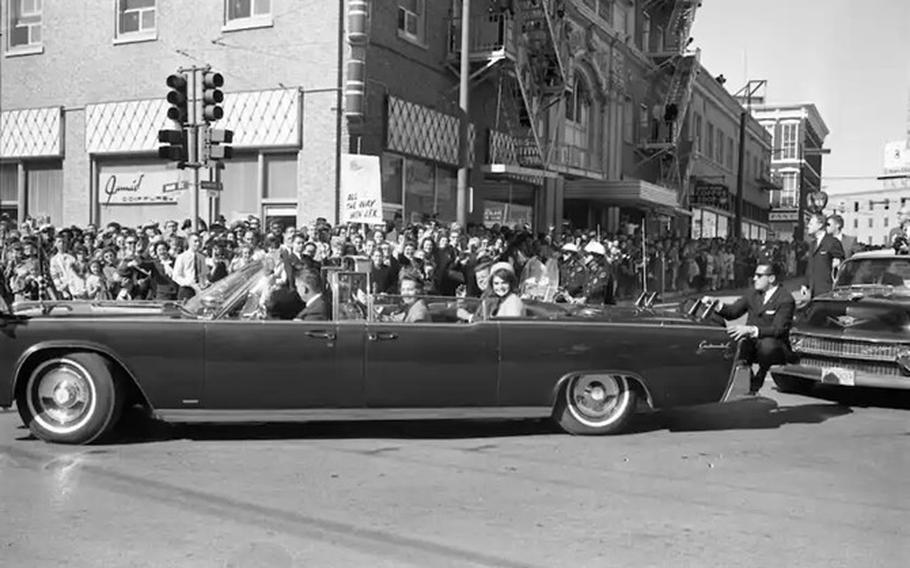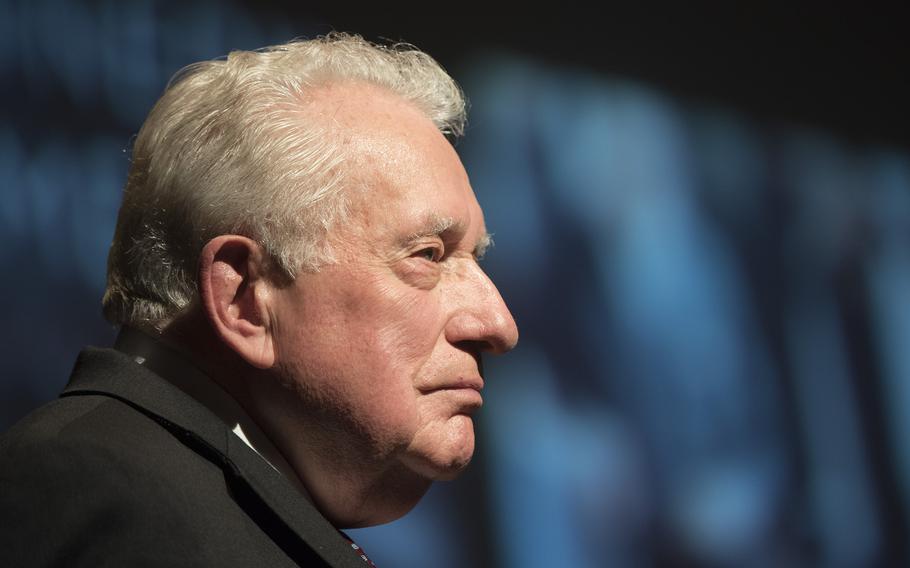
Agent Clint Hill crouches on the back bumper of the presidential limousine on Main Street in Dallas, Texas, just minutes before the assassination, Nov. 22, 1963. (Erin Thompson/U.S. Army)
Under the stained glass and towering arch ceilings of Washington National Cathedral, hundreds of Secret Service members paid their respects Tuesday to an agent who came to symbolize the elite agency’s commitment to bravery and sacrifice in the face of danger.
Secret Service agent Clint Hill had hurled himself atop President John F. Kennedy’s uncovered limousine when Lee Harvey Oswald opened fire on the presidential motorcade in Dallas in November 1963.
His attempts to shield Kennedy and first lady Jacqueline Kennedy from the shots that killed the president inspired thousands of Secret Service agents who came after him, while the experience left Hill, who died Feb. 21 at his home in Belvedere, California, at age 93, with a deep guilt that haunted him late into his life.
Generations of agents gathered Tuesday morning in the cathedral nave — the place where the country has memorialized Supreme Court justices, first ladies and presidents. They watched as an honor guard carried Hill’s urn, draped in a gold pall, through the solemn hall and rested it on a table between the folded flags of the United States and the Secret Service.
Some of those in attendance had worked alongside Hill during his 17-year career with the service. Others, he mentored. All knew his actions well.
“He understood duty and sacrifice, and the profound sense of purpose that comes from protecting others, as well as the emotional toll that can carry,” former Secret Service director Lewis Merletti, who led the agency in the late 1990s, said in a eulogy. “He made us proud.”
Hill rode on the left-front runner of the vehicle tailing Kennedy’s limousine as the motorcade wove through downtown Dallas on Nov. 22, 1963.
The motorcade had rounded a corner toward a freeway when Hill heard an explosive crack. He saw Kennedy grab his throat.
Realizing they were under fire, Hill jumped off the runner and dashed toward Kennedy’s limousine.
A second shot sounded, then a third, this one tearing through Kennedy’s head. Hill grabbed the trunk handrail just as the driver accelerated, and he thrust his body toward the mortally wounded president and his wife.
“We saw that with every step of his sprint to President Kennedy’s limo, he tried. And we all wanted to try just as hard as he tried,” Merletti said, his voice quavering.
Several agents in the audience wiped their eyes.
“Everyone in the Secret Service who ever served on a protective assignment,” Merletti said, “hoped they could react the way Clint reacted.”
Hill’s actions were immortalized in footage known as the Zapruder film, as well as an Associated Press photograph showing Hill, an anonymous agent in a dark suit, hunched over the rear of the vehicle as it sped away.
What happened next was not captured on film. As Hill recounted in later writings and interviews, he continued to shield the Kennedys with his body on the way to Parkland Memorial Hospital. When they arrived, he placed his suit jacket over the president’s head and upper torso.
Inside the hospital, Hill fielded a call from Kennedy’s brother, Attorney General Robert F. Kennedy. How bad was it, the younger Kennedy asked. “It’s as bad as it can get,” Hill replied. Doctors pronounced Kennedy dead soon after.
Hill accompanied Kennedy’s body to the autopsy. He got home the morning of Nov. 23, returning to the White House soon after to help Jacqueline Kennedy collect her husband’s belongings.
Hill protected Jacqueline Kennedy and her family for a year after the assassination, then went on to serve Presidents Lyndon B. Johnson, Richard M. Nixon and Gerald Ford. He retired in 1975, at age 43, as assistant director of the service’s protective forces.

Clint Hill appears at the LBJ Presidential Library on Thursday, Nov. 30, 2017. (Jay Godwin/LBJ Presidential Library)
Hill, who was born in North Dakota, had joined the service in 1958 after serving as a counterintelligence officer in the Army and briefly working in corporate security. He started out protecting President Dwight D. Eisenhower’s mother-in-law in the Denver area, then was transferred to Washington to work the Eisenhower detail in 1959. He was assigned to protect Jackie Kennedy the following year — a job he initially viewed as a demotion but soon came to love.
Shortly after his retirement, Hill’s suppressed anguish over the assassination spilled out in an interview with Mike Wallace on “60 Minutes.” Wallace asked if Hill or the service could have done anything to prevent Kennedy’s death. Hill, speaking through tears, said he blamed himself for not reacting quicker and would have given his life to save the president’s.
Hill struggled with depression long after he left the service. He said in books and interviews that he lived reclusively for years, drinking and smoking heavily and isolating himself from friends.
One turning point came in 1990, when he visited Dealey Plaza, the assassination site in Dallas, for the first time since 1963. There, he would say, he finally accepted that he had done all he could to protect Kennedy.
In 2009, Hill met the woman who would become his second wife, journalist and author Lisa McCubbin Hill. She had teamed up with one of Hill’s fellow former agents to write a book about working on the Kennedy detail.
In Tuesday’s service, Lisa McCubbin Hill recalled their first meeting: a two-hour interview at a hotel in Washington for the text.
He had vowed never to write a book about his experiences, and they did not discuss the assassination in the interview. But over time, he opened up about it, she said.
She recalled what Hill would tell other law enforcement officers and veterans about how he reconciled with his grief and trauma: “Find someone you trust and tell your story. You can begin to live again.”
The couple would go on to write four books together about Hill’s time in the service.
“Two hours turned into 15 amazing years,” she said, calling their relationship a “once-in-a-lifetime love that everyone hopes for.”
She described him as a music lover — a fan of Frank Sinatra, the Bee Gees and Lady Gaga. He was a consummate gentleman, she said, who held their longtime housekeeper in the same esteem as he did their friend Antony Blinken, the former secretary of state, who was one of several dignitaries who attended.
Officials from Secret Service headquarters also attended, including Director Sean Curran, the former head of Donald Trump’s detail. Nearly nine months ago to the day, Curran covered Trump at a campaign rally in Butler, Pennsylvania, to shield him from a gunman’s bullets.
At the end of the funeral, Curran presented the flag of the Secret Service to Hill’s wife.
They spoke quietly for a moment, their hands folded over one another’s. The widow pulled the flag close to her body and looked ahead.
The mourners soon exited, and a noble chapter in Secret Service history closed with the cathedral doors.